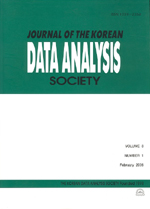동적다요인모델과 BLH모델을 이용한 포트폴리오 투자전략의 성과에 관한 연구
A Study on a Method for Portfolio Construction using Dynamic Multi-Factor Model and Black-Litterman-Herold Model
- 한국자료분석학회
- Journal of The Korean Data Analysis Society (JKDAS)
- Vol.13 No.5
-
2011.102599 - 2613 (15 pages)
- 이용수 13

키워드
초록
Fama와 French(1992)의 3요인모델은 기업의 특성요인으로 주가수익률의 횡단면적 차이에 대한 설명을 가능하게 하였고, 이를 이용해 초과수익을 추구하는 다양한 투자전략이 제시되어 왔다. 본 연구에서는 17개의 요인들을 제시하고 이들의 설명력을 요인과 주가수익률의 상관관계를 나타내는 지표인 위험조정요인결정계수(risk-adjusted factor IC)를 이용하여 살펴보며, 자산배분모델 중 하나인 블랙-리더만-헤롤드(BLH)모델에 요인값들을 개별 주식에 대한 전망(View)으로 사용하여 포트폴리오를 구성한 투자전략이 초과수익을 얻을 수 있는지 분석하였다. 분석결과, 17개의 요인 중 BP*ROE 등 16개의 요인이 유용한 변수로 나타났으나 시계열분석 시 주가수익률과의 상관관계가 변화하는 구간이 있어 단일요인보다는 다수의 요인을 적용하는 것이 더 적합하다고 판단되었으며, 다수의 요인들에 적용하는 가중치를 동적으로 변화시켜 얻은 포트폴리오가 유의하고 안정적인 초과수익을 얻을 수 있는 것으로 나타났다.
Since Fama and French (1992)’s 3-factor-model explained the cross-sectional difference of stock returns using companies’ characteristic factors, many investment strategies using a multi-factor model were suggested. In this research, risk-adjusted factor IC, which is correlation between factors and stock returns, are used as measure for the power to explain the cross-sectional difference of stock returns. And Black-Litterman-Herold model is used for the portfolio construction with the views from the multi-factor model. This research shows that 16 single ones out of 17 factors have significant power to explain the cross-sectional difference of stock returns, and the performance of a portfolio with dynamic multi-factor model is more significant, robust and profitable than those with single factor model.
목차
1. 서론
2. 선행연구
3. 자료 및 연구모형
4. 실증분석
5. 결론
6. 제언
참고문헌
참고문헌 (0)
등록된 참고문헌 정보가 없습니다.
해당 권호 수록 논문 (0)
등록된 수록 논문 정보가 없습니다.